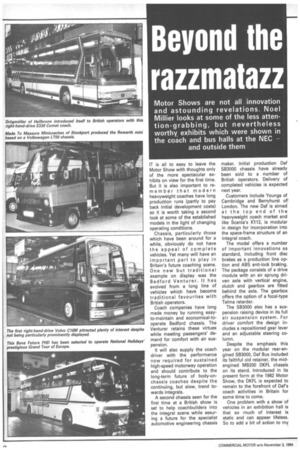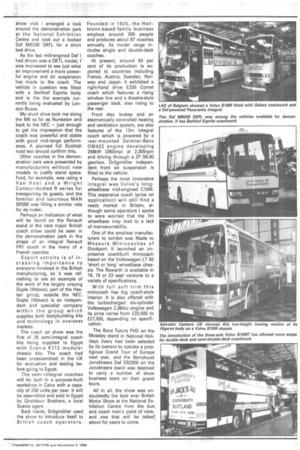Beyond the razzmatazz
Page 50

Page 51

If you've noticed an error in this article please click here to report it so we can fix it.
Motor Shows are not all innovation and astounding revelations. Noel Millier looks at some of the less attention-grabbing, but nevertheless worthy, exhibits which were shown in the coach and bus halls at the NEC - and outside them
IT is all to easy to leave the Motor Show with thoughts only of the more spectacular exhibits on view for the first time. But it is also important to remember that modern heavyweight coaches have long production runs (partly to pay back initial development costs) so it is worth taking a second look at some of the established models in the light of changing operating conditions.
Chassis, particularly those which have been around for a while, obviously do not have the appeal of complete vehicles. Yet many will have an important part to play in Britain's future coaching scene. One new but traditional example on display was the Bedford Venturer. It has evolved from a long line of vehicles which have become traditional favourites with British operators.
Coach companies have long made money by running easyto-maintain and economical-tooperate Bedford chassis. The Venturer retains these virtues while meeting passengers' demand for comfort with air suspension.
It will also supply the coach driver with the performance now required for sustained high-speed motorway operation and should contribute to the long-term future of body-onchassis coaches despite the continuing, but slow, trend towards integrals.
A second chassis seen for the first time at a British show is set to help coachbuilders into the integral scene while assuring a future for the specialist automotive engineering chassis maker. Initial production Daf SB3000 chassis have already been sold to a number of British operators. Delivery of completed vehicles is expected next year.
Customers include Youngs of Cambridge and Berryhurst London. The new Daf is aimed at the top end of the heavyweight coach market and like Scania's K112, is modular in design for incorporation into the space-frame structure of an integral coach.
The model offers a number of important innovations as standard, including front disc brakes as a production line option and ABS anti-lock braking.
The package consists of a drive module with an air sprung driven axle with vertical engine, clutch and gearbox are fitted behind the axle. The gearbox offers the option of a focal-type Telma retarder.
The SB3000 also has a suspension raising device in its full air suspension system. For driver comfort the design includes a repositioned gear lever and an adjustable steering column.
Despite the emphasis this year on the modular rear-en gined SB3000, Daf Bus included its faithful old retainer, the midengined MB200 DKFL chassis on its stand. Introduced in its present form at the 1982 Motor Show, the DKFL is expected to remain to the forefront of Daf's coach activities in Britain for some time to come.
One problem with a show of vehicles in an exhibition hall is that so much of interest is static and can appear lifeless. So to add a bit of action to my show visit I arranged a look around the demonstration park at the National Exhibition Centre and took out a bodied Daf MB200 DKFL for a short test drive.
As the last mid-engined Daf I had driven was a DKTL model, I was impressed to see just what an improvement a more powerful engine and air suspension has made to the coach. The vehicle in question was fitted with a Berkhof Esprite body and is the the example currently being evaluated by London Buses.
My short drive took me along the M6 as far as Nuneaton and back to the NEC — just enough to get the impression that the coach was powerful and stable with good mid-range performance. A planned full Scottish road test should confirm this.
Other coaches in the demonstration park were presented by manufacturers without new models to justify stand space. Ford, for example, was using a Van Hool and a Wright Contour-bodied R series for transporting its guests, and the familiar and luxurious MAN SR280 was filling a similar role for its maker.
Perhaps an indication of what will be found on the Renault stand at the next major British coach show could be seen in the demonstration park in the shape of an integral Renault FR1 coach in thp livery of a French operator.
Export activity is of increasing importance to everyone involved in the British manufacturing, so it was refreshing to see an example of the work of the largely unsung Duple (Metsec), part of the Hestair group, outside the NEC.
Duple (Metsec) is an indepen dent and specialist company within the group which supplies both bodybuilding kits and technology in overseas markets.
The coach on show was the first of 25 semi-integral coach kits being supplied to Egypt with Scania K112 modular chassis kits. The coach had been preassembled in the UK for evaluation and testing before going to Egypt.
The semi-integral coaches will be built in a purpose-built workshop in Cairo with a capacity of 250 units per year. It will be assembled and sold in Egypt by Ghabbour Brothers, a local Scania agent.
Back inside, Ditgmoller used the show to introduce itself to .British coach operators. Founded in 1920, the Heilbronn-based family business employs around 300 people and produces about 87 coaches annually. Its model range includes single and double-deck coaches.
At present, around 50 per cent of its production is exported to countries including France, Austria, Sweden, Norway and Japan. It exhibited a right-hand drive E330 Comet coach which features a rising window line and a theatre-style passenger deck, also rising to the rear.
Front disc brakes and an electronically controlled heating and ventilation system, are also features of the 12m integral coach which is powered by a rear-mounted Daimler-Benz 0M422 engine developing 206kW (280bhp) at 2,300rpm and driving through a ZF S6.90 gearbox. Drogrn011er independent front air suspension is fitted to the vehicle.
Perhaps the most innovative integral was Volvo's long wheelbase mid-engined C10M.
This expensive coach (price on application) will still find a ready market in Britain, although some operators I spoke to were worried that the 7m wheelbase may lead to a lack of manoeuvrability.
One of the smallest manufacturers to exhibit was Made to
Measure Minicoaches of Stockport. It launched an impressive coachbuilt minicoach based on the Volkswagen LT 50 'short or long' wheelbase chassis. The Rowarth is available in 16, 19 or 23 seat versions to a variety of specifications.
With full soft trim this minicoach has big coach-style interior. It is also offered with the turbocharged six-cylinder Volkswagen 2,384cc engine and its price varies from £22,500 to £27,000, depending on specification.
The Bova Future FHD on the Moseley stand in National Holi days livery had been selected by its owners to operate a prestigious Grand Tour of Europe next year, and the Berryhurst Jonckheere Daf SB2300 on the Jonckheere stand was destined to carry a number of show business stars on their grand tours.
All in all, the show was undoubtedly the best ever British Motor Show at the National Exhibition Centre from the bus, and coach men's point of view, and one that will be talked about for years to come.








































































































